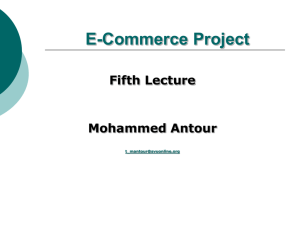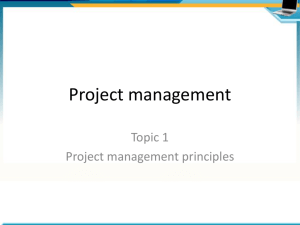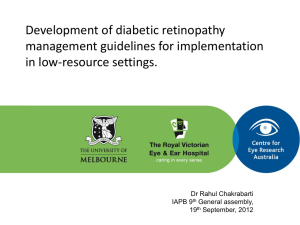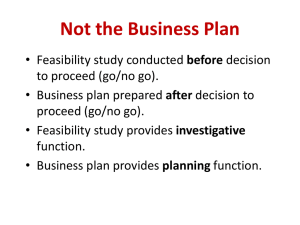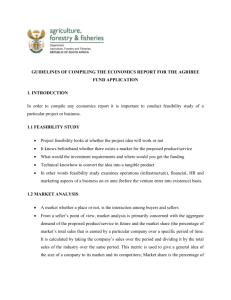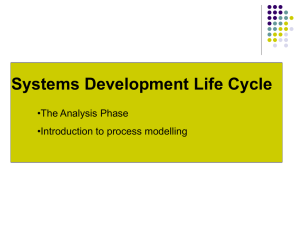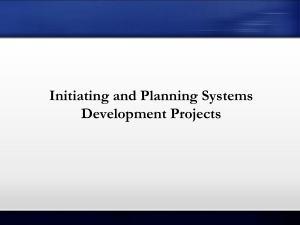Project Initiation - School of Engineering and Information Technology
advertisement
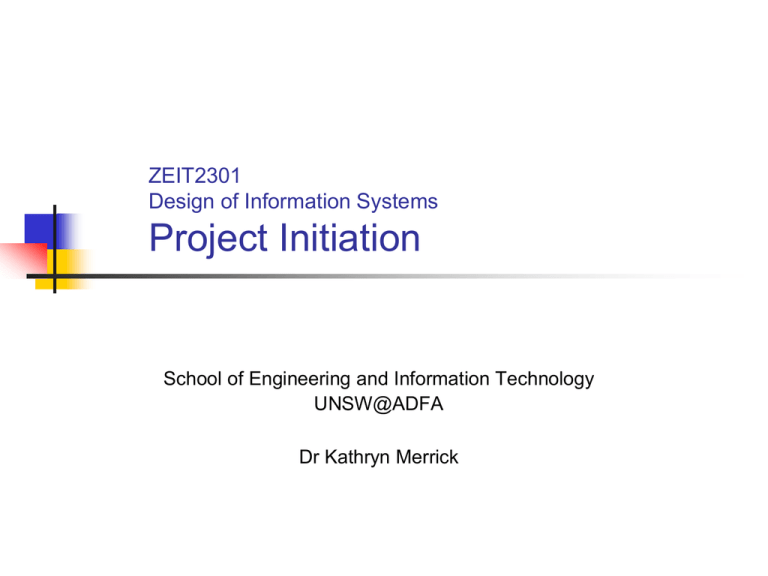
ZEIT2301 Design of Information Systems Project Initiation School of Engineering and Information Technology UNSW@ADFA Dr Kathryn Merrick Topic 02: Project Initiation Objectives To appreciate the importance of linking the information system to business needs To describe project initiation To describe the elements of a feasibility analysis (aka Advisability report) Reference: Text Ch 2 2 The Goal: Successful Projects Cost At project completion, no more money has been spent than was originally allocated Schedule The project is delivered no later than the original delivery date Performance When delivered, the project has all features and functionality that were originally required of it 3 Project Identification Projects are driven by business needs Identified by business people Identified by IT people (better yet) identified jointly by business and IT The project sponsor believes in the system and wants to see it succeed Normally this is a business person Should have the authority to move the project forward 4 Reasons for Project Initiation Respond to opportunity Resolve problem Conform to directive (Eg: government legislation) Implementing long-term IS strategic plan Responding to issues from department managers or process managers Response to outside forces (Eg: competitors) 5 A System Request A system request lists the key elements of the proposed project: Project sponsor Business need Business capabilities the system will need to have Business value Reason prompting the project (a key criterion for success) Business requirements Primary point of contact for the project Benefits the organization can expect from the project Special issues Anything else that should be considered 6 Planning Phase of SDLC Planning begins once a project has been approved. Define problem (more precisely) Confirm project feasibility Produce project schedule Staff the project Launch the project 7 Project Feasibility (aka Advisability) Feasibility analysis is used to aid in the decision of whether or not to proceed with the IS project. Helps identify potential risks that must be addressed Aspects of project feasibility 1. 2. 3. 4. Technical Economic Organizational and cultural Schedule and resource 8 1. Technical Feasibility Bleeding edge technology? Do we have the appropriate expertise within the company? Project size? Familiarity with the particular application Familiarity with the overall technology Compatibility with other systems Can we build it? 9 2. Economic Feasibility Development costs Annual operating costs Recurring costs Annual benefits One-off costs recurring cost savings and revenues Intangible costs and benefits Should we build it? 10 3(a) Organizational Feasibility Stakeholders Project champion(s) Senior management Users Others Is the project strategically aligned with the business? Sessin 2, 2010 If we build it, will they come? 11 3(b) Cultural Feasibility Each organizations has its own culture New system must fit into culture or have a determined “champion” who is able to drive change Project failure is often more a result of organizational issues (personnel, management style/support, etc) than the technical issues (development methodologies, h/w and s/w, etc) 12 Stakeholder Analysis Considers: Organizational management Are they committed to the project? System users Who are they and what is their attitude to the project? Do we have a project champion capable of supporting the project through the rough times? 13 Organizational and Cultural Risks Computer competency Computer phobia Perceived loss of control by some staff Shifts in organizational power Fear of changing job responsibilities Fear of employment loss Reversal of longstanding procedures 14 4. Schedule and Resource Feasibility Developing a project schedule inevitably involves some assumptions and therefore risk Requirements, and therefore scope, of the system might be unclear A fixed deadline increases risk (eg must be ready for Christmas shopping period) Need for sufficient skilled staff Need for adequate resources for systems development and for testing Can we build it? 15 Economic Measures Cost-Benefit Analysis 1. Shows costs and benefits over a particular time Net Present Value (NPV) 2. Return on Investment (ROI) 3. Takes into account the future value of money over the life of the system The difference between benefits and costs Break-even point The time point where the costs of the project equal the value of the benefits received 16 Simple Cash Flow Method for Cost Benefit Analysis 17 1. Net Present Value Present Value $amount / (1 + interest rate)n where “n” is the number of time periods Considers the time value of money $1 today does not have the same value as $1 in 5 years time Net Present Value The present value of benefits less the present value of costs 18 2. Return on Investment (ROI) The amount of money an organization receives in return for what it spends Total (benefits – costs) / total costs As a percentage High ROI means benefits far outweigh costs 19 3. Break-Even Point Break-even point is the time at which benefits exceed costs 20 3. Break-Even Point Examines the cash flow over time Identifies the year in which the benefits are larger than the costs The longer it takes to break even, the higher the project’s risk. Often represented graphically Plot the cumulative present value of the costs and of the benefits 21 22 Intangible benefits / costs But costs and benefits cannot always be measured in economic terms Intangible Benefits May be intangible but still an important criteria of project success Increased levels of service Customer satisfaction Business survival Need to develop in-house expertise Intangible Costs Reduced employee moral Lost productivity Lost customers or sales 23 CBA Formulae Summary 24 Project Selection Project portfolio management A process that optimizes project selection and sequencing in order to best support business goals Business goals are expressed in terms of Quantitative economic measures Business strategy goals IT strategy goals Once selected, projects enter the project management process 25 Ranking and Classifying Projects 26 How Not to Select a Project First in, first out Political clout of project inventor/proposer Squeaky wheel getting the grease Any other method that does not involve a deliberate analysis A recent analysis found that between 2% and 15% of projects taken on by IT departments are not strategic to the business. 27 Classic Risks in IS development Unclear objectives Limited user involvement Lack of executive support Poor planning Overly optimistic schedule Incomplete or changing requirements Failing to monitor or update schedule Adding people to a late project Lack of required resources 28 Summary A new IS project may be initiated when an opportunity or a problem is identified. A System Request highlights the business value of the proposed new information system. The feasibility study (aka advisability study) considers aspects such as the technical, economic and organizational feasibility. The overall portfolio of proposed projects is evaluated before a particular project is selected for development. 29

